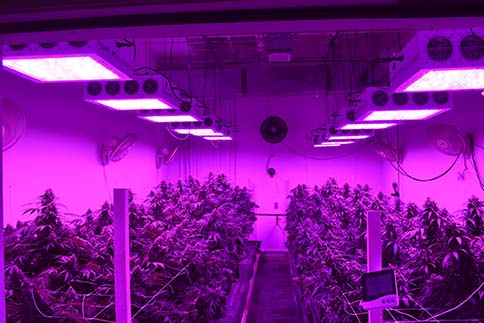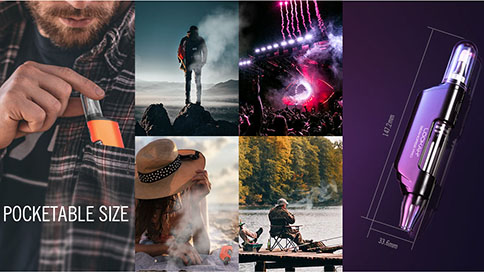How Science & Gadgets Revolutionized the Weed Industry
How Science & Gadgets Revolutionized the Weed Industry
Somewhere in the vast world of weed consumers, there will be someone vaping butane extracted concentrate in a portable vape pen that was extracted from weed grown under LED lights, and all this was purchased online.
Technology permeates every part of the cannabis industry, from growing marijuana, making extracts, consuming concentrates, and even selling and delivering all these products. The tale of how weed became such a tech industry is one we will cover in this article.
The history of cannabis goes back thousands of years, with the cannabis plant being used recreationally and medically through China, Central Asia, and Mesopotamia. We can't be sure exactly who was first to use cannabis for its psychotic effects, probably because anyone doing so back then was too high to be bothered to write anything down about it. Still, from old herbal medical books and religious practices, we can be certain that smoking cannabis for its therapeutic and recreational uses goes back to ancient times. A few thousand years later, it may appear at first that not much has changed; the majority of cannabis users still put flame to herb and use combustion as the way to enjoy marijuana, whether that be with a blunt, a bong, or a chillum.
But the last ten years or so has seen a big shift in the cannabis world. Technology has introduced different ways to consume, grow, and process cannabis.

Image credit: medium.com
Grow lights
Cannabis is a native plant that grows naturally and is abundant in tropical latitudes and equatorial regions from Colombia to Southeast Asia via Lebanon, Afghanistan, India, and other such areas, which have an ideal climate for cultivating cannabis outdoors.
However, plenty of places don't enjoy these long hours of daily sunshine and warm weather. To recreate these balmy climates in Northern Europe or North America, grow operations were focused on moving indoors. This move inside also helped hide what was then in many places still and illegal business. In order to bring the much-needed light for growing indoors, growers turned to electric lamps. These allowed crops of cannabis to be grown in everything from basements and garden sheds to warehouses. Fifteen years ago, you would have needed to go to a specialist store to find the necessary light bulbs for an indoor growing operation. The most common options were high-pressure sodium (HSP) and metal-halide (MH) bulbs. While these are still used by some today due to their proven effectiveness, the game has moved on. Their dominance in the cannabis growing industry has been replaced by lamps with an array of light-emitting diodes (LEDs).
The high-intensity MH and HPS bulbs were increasingly being replaced by cheaper, longer-lasting, and more economical to run LED clusters. Around ten years ago, the growing culture was full of articles discussing the future of LED lights and if they were better at providing the light strata for promoting plant growth, etc. As LED lights continued to develop, they soon convinced most critiques and dominated the market share.

The Rise of Vaporizers
The word "vape" may have been around since the 1980s, but it didn't enter most people's lexicon until the early, notably becoming Oxford Dictionary's word of the year in 2014, which was likely down to the growing rise of e-cigs for vaping.
However, vaping in the cannabis world was around before then, with a prototype desktop vaporizer developed by Frank William Wood, AKA Eagle Bill, on show at the 1994 annual cannabis cup that was held in Amsterdam that year.
Cannabis vapes use a convection or conduction method to heat the dry herb to between 120 and 200ºC. It is essentially boiling the active THC and CBD compounds out of the plant into a vapor form, which is then inhaled. This is seen as a healthier alternative to combustion due to the lack of carcinogens and other compounds that are created when burning cannabis.
One of the most popular desktop vapes is the volcano. This classic vaporizer first appeared around 2000 and is the main feature in many Amsterdam coffee shops or weed cafes. The 20+ year history of this vape makes it an absolute classic with a cult following that ensures Storz & Bickel a seat in vaporizer history. Since then, a number of vaporizers have come to the market, with many of these are more portable, similar to the e-cig pens popular for nicotine vaporizers.
Vapes aren't just for dry herb anymore either, with concentrate pens for cannabis oil, waxes, and other cannabis concentrates. Other vaporizes have sought to make the dab rig experience portable and electronic. These electric dab rigs are some of the more popular vaping gadgets of late. They combine the cool water filtered hits you get from taking dabs from a water pipe but do away with the cumbersome rigs and butane heating torches, which makes traditional dabbing only suitable for doing at home.

Development of Concentrates
Perhaps the most familiar cannabis concentrates is hashish; it's made by collecting together the trichomes that surround the buds of the cannabis plant. These are mashed together, making a sticky resiny goo. It's been made for centuries and is popular throughout India and Afghanistan. Hashish is also common across North Africa, although that's generally a lighter color and made slightly differently. However, both are essentially the same.
Technological advances have now made a new range of cannabis concentrates available through new extraction techniques using solvents.
Unlike solvent-less concentrates such as hashish and kief, these newer substances are extracted using a solvent such as butane, propane, or carbon dioxide.
As you will likely remember from chemistry class, a solvent is a liquid that dissolves a solid, producing a liquid solution.
These new products have names such as crumble, wax, shatter, budder, and many more. Their names are often reflected in the color and consistency of the extract.
While some of these could be created at home, it can be somewhat dangerous, especially if using butane or propane, so these concentrates are made under laboratory-like conditions, often with huge and expensive machines.
Concentrates are many times more potent than cannabis, and the growth in the legalization of recreational cannabis is helping drive this market in the USA and Canada.
Buying Online
Everything seems to be available online nowadays, and drugs are no exception. While before, you could buy illegally through dark websites like silk road, that's not needed in the world of legalized cannabis we now live in.
So you'll no longer be hanging around on the street waiting for the dealer to show when with a few clicks of a mouse, you can have them coming to your door with your favorite herb or concentrate.
In the USA, it's still illegal to send cannabis and cannabis products through the postal system, but there are many delivery services in states where cannabis consumption has been made legal. As legalization grows, so will the options for home weed deliveries.
Want to grow your own weed? You can now in many places, and you don't need to leave home to do so. Everything you'll need from seed, soil, lights through to rolling papers is available online.
There are dozens of online headshops, all vying for a slice of the growing cannabis market. Vapes, bongs, and all manner of paraphernalia are easily available online with discreet shipping. These online headshops can have a wide range of stock and cater to the masses because they needn't keep shelf space for their range of products. This can often lead to greater savings being passed onto the customer.
The cannabis business has embraced and taken advantage of technology.
